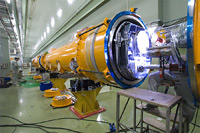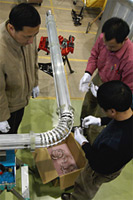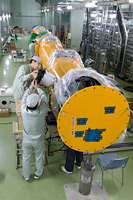 |
 |
|||||||||||||
|
|||||||||||||
|
|||||||||||||
|
An important prerequisite for building the ILC is to establish the design and manufacturing of major and vital components, such as cryomodules for the main linacs through realistic operating conditions. The Tesla Test Facility (FLASH) at DESY and Fermilab’s ILC Test Area have been pursued to play critical roles in the European and American regions to this end. KEK also aims to serve as an Asian regional center for the main linac technology, and their STF (Superconducting RF Test Facility) and R&D programs are a manifestation of its endeavour. Many members of STF from KEK are active members in the GDE and in close collaborative relationships with colleagues from DESY, INFN, Orsay, FNAL, JLab, Cornell and SLAC. Major laboratories from China, Korea, and India, have expressed their interests or have already begun interactions with the programme at STF in various forms also. The intended goal of STF is for Asian scientists and engineers in both the research and industrial sectors to acquire the necessary competitiveness in constructing the main linacs for the ILC. The program at STF is staged roughly in two phases, STF Phase 1 and STF Phase 2. The members of STF, through their Phase 1 programme, aim to efficiently and quickly learn the essential technologies for the ILC main linacs, such as fabrication of 9-cell cavities with good performance, design and assembly of cryomodules, construction and operation of RF power distribution and controls. Preparation of the basic infrastructure, such as a dedicated clean room, assembly area, surface treatment facilities, and test stands, is another critical agenda item. The Phase 1 program started in late 2004.
The cavity package is a system which incorporates high gradient 9-cell cavities enclosed in vacuum-tight jackets. These jackets contain superfluid liquid helium and connect to tuners, which are responsible for maintaining the resonant frequencies of the cavities during operation. This cavity package is enclosed within a two-layered heat insulator (at 5K and 80K), which in turn, is contained within a long, cylindrical vacuum vessel. This entire assembly is called cryomodule. An input coupler which supplies RF power is connected to each cavity from outside of the cryomodule. (See symmetry magazine, Oct./Nov. 2006) More than 40 members from KEK are engaged in the cryomodule engineering research, subdivided into several groups such as cryostat, cavity, liquid helium generation and supply, and high power microwave. Assembly of the cryomodule, first starting with preparation of the cavity packages, began in November 2006. Input couplers, sensors, antennas and gate valves are installed on the 9-cell cavity in a clean room. These cavity packages are then installed underneath the gas return pipe of the cryomodule. While the position of each cavity on end is firmly fixed on an invar rod, a sliding mechanism allows each cavity to shrink or expand during cool down and heat up without affecting their longitudinal relative alignment. After a precision mechanical survey, welding work is done on many tubing, and heat shield materials are applied. The initial model of the STF cryomodule incorporates a wire position monitor system, which monitors the transverse alignment of components during cool down. Most of the assembly work for the cryomodule is now complete, pending a final inspection of the vacuum tightness of the outer vacuum vessel. "This is our first experience to build a ILC-like module. So far, so good. Right now, the work status is one week ahead of the schedule," Hitoshi Hayano, leader of a STF group, says. He further explained that by the end of March, a vacuum testing will be done on the cryomodules and delivery of liquid helium to the accelerator tunnel will begin. At that time they will be ready for the first cool down test of ILC-like cryomodule in Japan. The Phase 2 plan is to design and construct the hardware components for one full RF unit, which is the same as one basic unit of the ILC main linac. There they intend to perform a longterm operation test with ILC like beam. Experiences from the STF Phase 2, together with lessons learned from test facilities in Europe and America, will critically contribute to accomplishing the Technical Design Report (TDR). -- Nobuko Kobayashi |
|||||||||||||
| © International Linear Collider |


